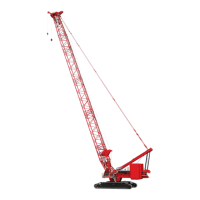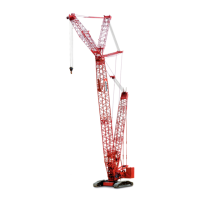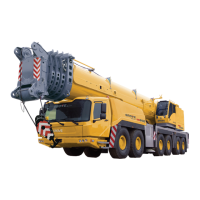HOISTS MLC300 SERVICE/MAINTENANCE MANUAL
5-42
Published 11-22-17, Control # 257-02
BLOCK-UP LIMIT INSTALLATION AND
ADJUSTMENT
General
The block-up limit control (also called anti-two-block device)
is a two-blocking prevention device which automatically
stops the load drum from hoisting and the luffing jib (and
boom) from lowering when a load is hoisted a predetermined
distance from either jib point.
Two-Blocking Definition
Two-blocking is the unsafe condition in which the load block
or the weight ball contacts the sheave assembly from which
either is suspended.
Two-blocking can result in failure of the sheaves and the wire
rope, possibly causing the load to fall.
The luffing jib block-up limit system consists of the following
components (see Figure 5-24
):
• A normally closed limit switch assembly fastened at
either or both of the following locations:
- Lower jib point
- Upper jib point
• A weight freely suspended by the chain from each limit
switch actuating lever (weight encircles load line as
shown)
• A lift block fastened to the load line or a lift plate fastened
to the load block
For identification and location of the block-up limit
components in the boom, see the Operator and Service
Manuals supplied with the crane.
Removing the Luffing Jib
When removing the luffing jib, it is necessary to disconnect
the electric cables from the jib at the electric cables in the
boom top.
Be sure to do the following.
1. Thoroughly clean all cable connectors and dust caps.
2. Connect the dust caps to the cable connectors.
3. Connect the terminators to the cables on the boom top.
Failing to perform this step will result in faulty operation.
Also, the fault alarm will come on in the main display.
WARNING
Two-Blocking Hazard!
The block-up limit control is a protective device designed
only to assist the operator in preventing a two-blocking
condition. Any other use is neither intended nor approved.
The block-up limit control may not prevent two-blocking
when the load is hoisted at the maximum single line
speed. The operator shall determine the fastest line
speed that allows the block-up limit control to function
properly and, thereafter, not exceed that line speed.

